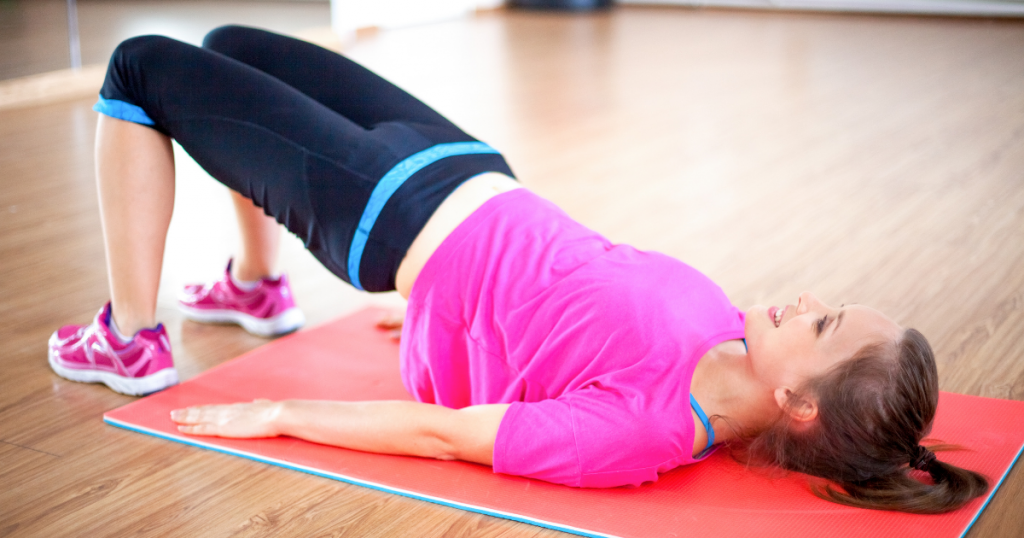Pelvic floor rehabilitation: advice and exercises

The pelvic floor is a layer of muscles covering the lower part of the pelvis. Their main function is to support the bladder and the intestines in men, as well as the uterus in women. Not by chance, these structures, which lie above the pelvic floor, are known as pelvic organs.
When these muscles are not toned and firm, especially in older persons, this may cause a number of problems, from erectile dysfunction to urinary incontinence, as well as others. In this article, our physiotherapists will explain the advantages of pelvic floor rehabilitation and a series of simple exercises you can do at home to learn to control this part of the body.
Where is the pelvic area? Some anatomical notes
The pelvic muscles develop like a kind of “hammock”, from the front of the pelvis to the coccyx, and from one ischial tuberosity to the other, sideways. This “hammock” is formed of two main structures: the levator ani muscle and the coccygeus muscle (or ischiococcygeus).
The pelvic floor muscles are able to move up and down, and this movement is fundamental because, when we breathe in, our diaphragm (i.e., the respiratory muscle) lowers to open the lungs, and when we breathe out, the diaphragm rises back to its normal position.
What does the pelvic floor do?
The pelvic floor helps many physiological functions, starting from containing the organs in the lower belly to preventing urine leakage, and can even improve sexual function.
Here is a list of all the main functions performed by the pelvic muscles:
- Supporting the pelvic organs in their correct positions (bladder, intestines and uterus).
- Ensuring self-control of bladder and intestinal functions using the sphincter muscles. This allows us to control the release of urine, faeces and intestinal gases, delaying their emptying until the appropriate moment.
- Sexual function: in men, the pelvic floor muscles are important for maintaining an erection during sex, and for preventing premature ejaculation. In women, on the other hand, training the pelvic floor muscles to contract can help to improve sexual relations.
- Relaxing and increasing the lung expansion space during breathing.
- During pregnancy, the pelvic floor offers excellent support for the foetus.
Strong, trained pelvic floor muscles help us to carry out even the simplest everyday activities, like coughing, laughing and lifting weights, as they give extra strength to the abdomen which helps us to support and contract the torso.
Symptoms of pelvic floor problems in men and women
People may experience several signals and symptoms when they have pelvic floor muscle problems. The following is a list of some of the most common problems caused by weakened pelvic muscles:
- Urinary dysfunction;
- erectile dysfunction;
- premature ejaculation;
- painful ejaculation;
- chronic pelvic pain.
Symptoms of pelvic floor dysfunction in men
- Constipation or intestinal tension.
- Localised pain in the pelvic area, genitals, rectum or pelvis, at times also during sexual relations.
- Pelvic prolapse: this may give a sensation of annoying pressure in the rectum or the need to go to the toilet even when this isn’t necessary.
- Accidental urine leakage when training, laughing, coughing or sneezing.
- An urgent need to go to the toilet, or to not make it in time.
- Frequent need to urinate or excrete.
- Difficulty in emptying the bladder (discontinuous urination – stopping and starting several times) and the intestines.
- Pain in the lower back which cannot be explained by other causes.
- Erectile dysfunction.
- Premature and/or painful ejaculation.
In particular, when talking of erectile function, the pelvic floor muscles contract to prevent blood leaving the penis. When the muscles are weak, the flow of blood from the penis is not interrupted, with consequent erectile dysfunction. Learning to control the pelvic floor muscles may therefore help to prevent premature ejaculation.
Urinary incontinence also has a direct relationship with the pelvic floor muscles. These muscles contract as a mechanism for closing the channel running from the bladder to the urethra, and this is why if these muscles are weak it can cause leakage and dripping.
Symptoms of pelvic floor dysfunction in women
- Pain or numbness during sex.
- Pain in the pelvic region, genitals or rectum.
- Prolapse: can be perceived as a swelling in the vagina (feeling/seeing a swelling or nodule inside or outside the vagina) or a sensation of heaviness, discomfort, traction, dragging or falling.
- Accidental urine leakage when training, laughing, coughing or sneezing (stress incontinence).
- An urgent need to go to the toilet, or to not make it in time.
- Frequent need to urinate.
- Difficulty in emptying the bladder (discontinuous urination – stopping and starting several times) and the intestines.
- The sensation of having to excrete often in a short period of time.
- Constipation or intestinal tension
- Accidental passing of wind
- Pain in the lower back which cannot be explained by other causes.
A prolapse is a common condition which may occur due to weak pelvic floor muscles in women. This happens when the uterus, bladder, intestines or upper part of the vagina move from their normal positions and push down on the vagina. This can cause pain and discomfort, but can be improved with pelvic floor exercises and changes in lifestyle. As happens with men, also with women urinary incontinence has a direct relationship with the pelvic floor muscles, which, if weakened, cause annoying leakages.
Remedies and treatments for pelvic floor dysfunctions
Pelvic floor dysfunctions are curable conditions. There are many ways to treat pelvic floor problems conservatively (i.e., without surgery) and should be considered as the first option.
The treatment depends on the type of condition or reason for the dysfunction.
Drug treatment
Various drugs can be prescribed depending on the cause of the pelvic floor problems.
For example, drug treatment is particularly common for urinary incontinence. The ageing process can cause hormone changes, which can have a negative impact on the pelvic floor muscles, causing increased laxity/stretching. Therefore, hormone replacement therapy for post-menopausal women can be used to manage or improve the symptoms.
If the person has an over-active bladder or urgency incontinence, on the other hand, there are drugs that can help to relax the bladder and reducing the urination frequency.
Drug treatments are even more effective if used in combination with other strategies, such as pelvic floor exercises and changes in lifestyle.
Surgical treatment
In some cases, when other conservative treatments have been unsuccessful, surgery may be the best option for curing pelvic floor dysfunctions.
Incontinence and prolapses can be treated with different types of surgical procedures, which aim to modify the pelvic structures or add supports, such as synthetic mesh strips.
It is estimated that out of all persons suffering from pelvic floor disorders, 1 out of 9 has surgery to solve the problem. However, there are risks that should be considered, as the surgery is not always successful and the conditions may return over time.
Slightly less invasive options are available, such as Botox injections for urgency incontinence or bulking agents to help reduce stress incontinence.
Pelvic floor rehabilitation
Physiotherapy is the primary treatment for pelvic floor dysfunctions. Although there is limited literature in this sector, some proof shows the importance of physiotherapy. Research has focused mainly on the role physiotherapists can play through education to changing lifestyles and the prescription of exercises that help to reduce the risk of undesirable symptoms.
The advantages of pelvic floor rehabilitation:
- Training the pelvic floor muscles has been shown to be beneficial for both urinary incontinence and prolapse symptoms.
- Training the pelvic floor also appears to improve sexual function.
- Training these muscles improves their function and contractility.
- Guidelines recommend a pelvic floor training programme with the supervision of a physiotherapist for at least three months as an initial treatment for those suffering from urinary stress or incontinence.
Gymnastics for the pelvic floor: useful excercises to do at home
Pelvic floor exercises are divided into contractions held for a short time and contractions held for a long time. Both are equally important for correct training and excellent pelvic floor muscle function.
The huge advantage of this type of gymnastics is that it can be done anywhere and autonomously: it takes just a few minutes a day (without sweating!) to keep our pelvic floor fit.
Short contractions
- Keep the pelvic floor contracted, imagining you are suddenly stopping the flow of urine and hold your breath at the same time.
- On/off contractions: tighten- release– tighten- release.
- Repeat 8-10 times at first, increasing the number of repetitions every week.
Short contractions train the rapid-contracting fibres in the pelvic floor muscle to react quickly to spontaneous movements such as coughing, sneezing and laughing. These fibres are activated rapidly to prevent leakages and problems. Training the pelvic floor muscles with these short, quick contractions can help to keep these fibres ready to react to any situation.
Long contractions
- Contract the pelvic floor muscle, imagining again that you are suddenly stopping the flow of urine, and hold your breath.
- Hold the contraction for as long as possible. This is difficult, but will set a starting point, which is the longest time achieved.
- Repeat this exercise 3-5 times, trying to increase the duration of the contraction every week.
Long pelvic floor muscle contractions train the function differently from short ones. This type of training strategy targets the slow-contracting fibres in the pelvic floor, which are responsible for strength and resistance. This ensures that the inner floor remains firm, tight and in the correct position for keeping all our internal organs just where they should be.




